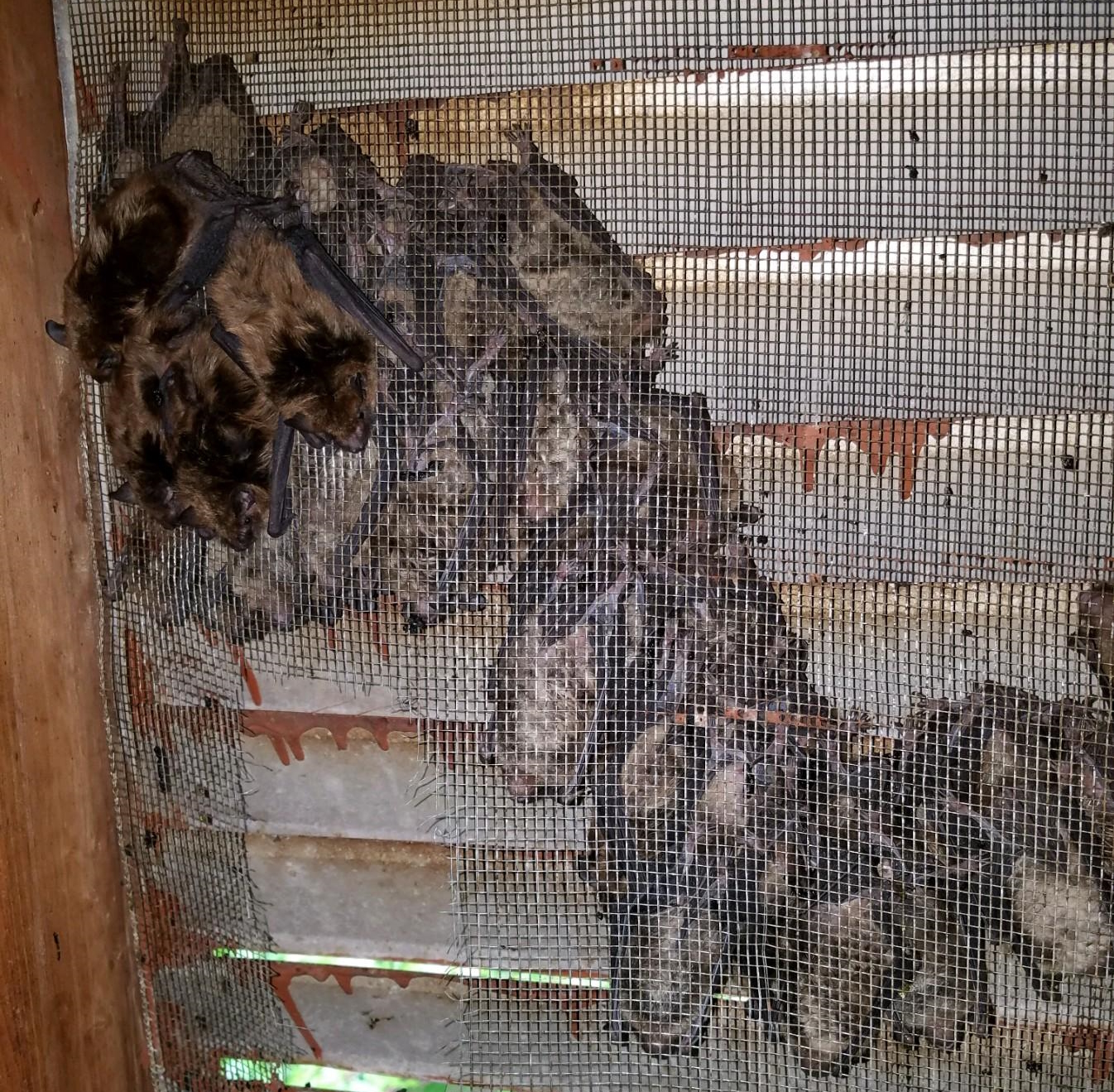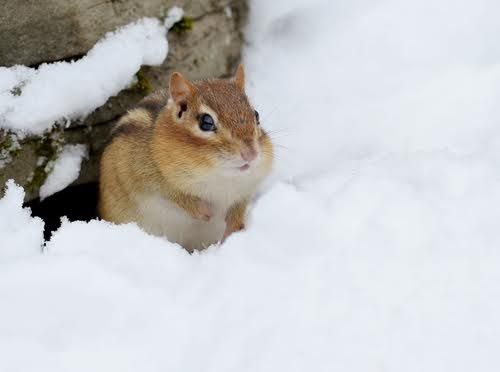There are thirteen different species of bats in Indiana. Although they don't pollinate, their insect-eating habits support the local ecological balance and benefit agriculture and forestry. In fact, it’s estimated that bats save North America’s agricultural industry more than $3.7 billion annually by providing natural pest control.
Six of the thirteen bat species in Indiana hibernate in caves and mines while the rest can be found roosting in trees or buildings. Perhaps, they’ve even made it inside your home or business. Despite the benefits these endangered creatures provide, you probably don’t want them getting too close. Call Varment Guard for expert and humane removal. Now, let’s take a closer look at Indiana bats.
The Thirteen Types of Bats in Indiana
- Indiana Bat (Myotis sodalis)
- Little Brown Bat (Myotis lucifugus)
- Northern Long-eared Bat (Myotis septentrionalis)
- Southeastern Myotis (Myotis austroriparius)
- Eastern Small-footed Bat (Myotis leibii)
- Big Brown Bat (Eptesicus fuscus)
- Eastern Red Bat (Lasiurus borealis)
- Hoary Bat (Lasiurus cinereus)
- Silver-haired Bat (Lasionycteris noctivagans)
- Evening Bat (Nyctalus noctula)
- Brazilian Free-tailed Bat (Tadarida brasiliensis)
- Tricolored Bat (Perimyotis subflavus)
- Eastern Pipistrelle (Pipistrellus subflavus)
Now let’s learn about the differences between each type of bat:
1. Indiana Bat
The Indiana bat, scientifically known as Myotis sodalis, is a federally-listed endangered species native to the state of Indiana. Much of their natural habitat, such as caves and forests, are being disturbed by human activities. Efforts to protect and restore these habitats are essential for the survival of the Indiana Bat.
Indiana Bat Characteristics:
- A medium-sized, dull gray bat.
- The length of its head and body ranges from 1.5 to 2 inches.
- Weighs about 1/4 of an ounce.
- Most bats are difficult to distinguish from their cousins unless examined closely. The size of the feet and the length of the toe hairs are characteristics used to differentiate the Indiana bat from other bats.
- Indiana bats live an average of 5 to 10 years, but some have reached 14 years of age.
Roosting
Indiana bats typically form large maternity colonies during the summer months. These colonies provide a safe environment where females can give birth and raise their young.
Reproduction
Female Indiana bats give birth to a single pup each year. This low reproductive rate makes the species particularly vulnerable to threats such as habitat loss and disturbances.
Foraging
Indiana bats use echolocation to hunt for insects. They commonly forage over bodies of water and along forest edges to find their prey efficiently.
Hibernation
Indiana Bats hibernate in caves where they form clusters to conserve energy. Hibernation is vital for their survival during the colder months when insects become scarce. Understanding hibernation patterns helps conservationists in creating strategies to protect hibernation sites and minimize disturbances.
2. Little Brown Bat
Native to Indiana, the little brown bat, myotis lucifugus or little brown myotis, plays a significant role in the state's ecosystem. Little brown bat populations are threatened by habitat loss, pesticide use, and white-nose syndrome– a fungal disease that has devastated many bat populations in North America. Conservation initiatives include protecting roosting sites, monitoring populations, and raising awareness about the importance of these bats in the ecosystem.
Roosting
Little brown bats roost in colonies in dark, secluded areas such as caves, trees, or man-made structures like attics and barns. They use echolocation to navigate and find shelter.
Reproduction
Little brown bats mate in the fall but females store the sperm until spring when fertilization takes place. They give birth to a single pup in early summer and nurse until it can fly and hunt on its own.
Foraging
These bats are nocturnal hunters that prey on a variety of insects such as mosquitoes, moths, and beetles. They can consume large amounts of insects in a single night, providing natural pest control.
Hibernation
Little brown bats hibernate during the winter months, typically in caves or mines where temperatures remain cool and stable. They enter a state of torpor or reduced metabolic activity to conserve energy during this period.
3. Northern Long-eared Bat
The northern long-eared bat, scientifically known as Myotis septentrionalis, is another bat found in Indiana that faces conservation challenges. Sadly, this species has faced population declines due to white-nose syndrome and are the target of conservation efforts.
Roosting
Northern long-eared bats are typically found in forests with mature trees where they roost in tree cavities during the summer months.
Reproduction
This species forms maternity colonies in their roosting sites where females gather to give birth and raise their young.
Foraging
These bats hunt for insects at night, using echolocation to navigate and locate their prey. They are particularly skilled at catching moths and beetles in flight.
Hibernation
Northern long-eared bats often choose caves, mines, or tunnels with stable temperatures to spend the winter months. During this time, they enter a state of torpor to conserve energy until spring.
4. Southeastern Myotis
The Southeastern myotis bat, scientifically known as Myotis austroriparius, is an adaptable creature that plays a vital role in controlling insect populations. While not as threatened as other Indiana bats, they still face threats such as habitat loss, reduced food sources due to pesticides, and disturbance to their roosting sites.
Roosting
The Southeastern myotis bat prefers to roost in caves, crevices, and sometimes buildings. They seek shelter in dark, secluded areas during the day.
Reproduction
These bats typically mate in the fall, with females storing sperm until spring for fertilization. They give birth to a single pup in early summer after a gestation period of about 3 months.
Foraging
Southeastern myotis are insectivores that prey on a variety of flying insects such as moths, beetles, and mosquitoes. They use echolocation to navigate and hunt for food during the night.
5. Eastern Small-footed Bat
Like other Indiana bat species, the eastern small-footed bat, scientifically known as Myotis leibii, contributes positively to their ecosystem. Due to their small population size and vulnerability to habitat disturbances, monitoring and safeguarding these bats is crucial for their continued existence in Indiana.
Roosting
Eastern Small-footed Bats prefer roosting in tight spaces like rock crevices, caves, and mines where predators have limited access.
Reproduction
Mating season typically occurs in the fall. Male eastern small-footed bats perform elaborate aerial displays showcasing their agility and strength to attract females.
Foraging
Similar to other bats, they consume small insects like moths, beetles, and flies, which they catch in flight using echolocation.
Hibernation
This species tends to migrate to warmer regions in the winter, seeking shelter in caves or mines where temperatures are more stable.
6. Big Brown Bat
The big brown bat (Eptesicus fuscus) is a common bat species found in Indiana and most of the United States. Big brown bats are threatened by habitat loss, pesticide use, and white-nose syndrome.
Roosting
Big brown bats are known to roost in a variety of places, including trees, caves, buildings, and bat houses. They prefer dark, secluded roosting spots where they can rest during the day.
Foraging
These bats have a diverse diet, feeding primarily on insects such as beetles, moths, and mosquitoes. Their foraging flights often occur near bodies of water where insect populations are abundant.
Reproduction
Big brown bats typically mate in the fall, but fertilization doesn’t occur until the following spring. Females form maternity colonies where they give birth to one or two pups in early summer.
Hibernation
While big brown bats are not known for long-distance migrations, some individuals may travel short distances to find suitable hibernation sites or to follow insect prey.
7. Eastern Red Bat
The eastern red bat, scientifically known as Lasiurus borealis, is a distinctive bat species native to Indiana. They are not considered a “species of concern” but still face man-made threats to their population.
Roosting
Eastern red bats are known for their roosting behavior, often preferring to roost in trees, shrubs, or foliage rather than caves or structures like many other bat species. This behavior helps them blend seamlessly with their surroundings, making them harder to spot.
Foraging
These bats primarily feed on flying insects like moths, beetles, and mosquitoes. Their agile flight allows them to capture prey on the wing efficiently.
Reproduction
Females give birth to 1-4 pups in late spring or early summer. The young are cared for by the mother until they are old enough to fend for themselves.
Hibernation
Eastern Red Bats are known to be migratory creatures, with some individuals traveling south for the winter to escape the colder temperatures. They may travel long distances during migration, making them fascinating subjects for research and observation.
8. Hoary Bat
Known for its distinctive frosted appearance and nocturnal habits, the hoary bat, scientifically identified as Lasiurus cinereus, is a notable bat species found in Indiana. The hoary bat is a subject of conservation concern due to habitat loss, pesticide use, and wind turbine fatalities.
Roosting
Hoary bats are solitary creatures that typically roost in trees, often hanging from branches or hidden in foliage as they rest during the day.
Reproduction
Mating occurs in the late summer and early fall, with females giving birth to one or two pups in the spring. The young are cared for and nursed by the mother until they are old enough to fend for themselves.
Foraging
Hoary bats have a diverse diet, feeding primarily on moths but also consuming other insects such as beetles, flies, and mosquitoes.
Hibernation
These bats are known for their long-distance migration, traveling south to warmer regions during the winter months and returning to northern areas for the summer.
9. Silver-haired Bat
With a distinctive silver-gray fur, the silver-haired bat, scientifically known as Lasionycteris noctivagans, is a notable bat species present in Indiana. This species faces threats from habitat loss, pesticide use, and white-nose syndrome.
Roosting
These bats exhibit interesting roosting habits, often preferring tree cavities or loose bark as their daytime shelters. They are known to be solitary creatures, roosting alone or in small groups.
Reproduction
The reproduction cycle of silver-haired bats involves mating in the fall, with females giving birth to a single pup in early summer. These bats have a relatively low reproductive rate compared to other species.
Foraging
In terms of diet preferences, silver-haired bats primarily feed on moths, beetles, and other flying insects. They are skilled hunters, using echolocation to locate their prey in the dark. This species plays a crucial role in controlling insect populations.
Hibernation
Silver-haired bats are known for their migratory patterns, often traveling long distances between their summer and winter habitats. During the warmer months, they can be found in Indiana, but in the colder seasons, they migrate to more favorable areas.
10. Evening Bat
The evening bat (Nyctalus noctula) is another intriguing bat species found in Indiana and known for its distinct characteristics and behaviors. Conservation efforts for this threatened species focus on preserving habitat and raising awareness.
Roosting
Evening bats are known to roost in tree cavities, abandoned buildings, and bat houses during the day. They prefer secluded roosting spots to avoid disturbances.
Reproduction
Evening bats typically mate in the fall, with females giving birth to a single pup in early summer. Mothers form maternity colonies to raise the young bats until they are ready to fly and forage on their own.
Foraging
These bats primarily feed on moths, beetles, and other flying insects that they catch in flight using echolocation.
Hibernation
While some evening bats in Indiana may migrate south for the winter, others hibernate locally if they find suitable conditions. Migration patterns can vary based on food availability and environmental factors.
11. Brazilian Free-tailed Bat
The Brazilian free-tailed bat, scientifically known as Tadarida brasiliensis, is a highly adaptable species found in various regions of the state. Continued monitoring and conservation efforts are essential to ensure the protection of these fascinating and beneficial creatures in Indiana and beyond.
Roosting
These bats exhibit unique roosting behavior, commonly residing in caves, bridges, and buildings in large colonies.
Reproduction
Brazilian free-tailed bats typically form large colonies for mating. Mating peaks during the warmer months, and females give birth to a single pup after a gestation period of about 12-14 weeks.
Foraging
Brazilian free-tailed bats prefer a diet consisting mainly of insects such as moths, beetles, and flying ants, which they catch mid-air using their echolocation abilities.
Hibernation
These bats are known for their long-distance migration patterns, with some populations traveling hundreds of miles between their summer and winter habitats.
12. Tricolored Bat
The tricolored bat, scientifically known as Perimyotis subflavus, is a small and agile species native to Indiana and other parts of North America. Due to factors like habitat loss, white-nose syndrome, and pesticide use, tricolored bat populations have faced declines.
Reproduction
Tricolored bats reproduce once a year, typically giving birth to a single pup. Maternity colonies form during the summer months to provide a safe space for nurturing the young.
Foraging
These bats primarily feed on moths, beetles, and other flying insects. Their foraging activities play a crucial role in controlling insect populations.
Hibernation
Tricolored bats typically hibernate during the winter months in caves, mines, or other secluded locations. They enter a state of torpor to conserve energy.
13. Eastern Pipistrelle
Occasionally mistaken for other bat species due to its small size and rapid flight, the eastern pipistrelle, scientifically known as Pipistrellus subflavus, is a notable insect-eating bat found in Indiana and various regions across North America.
Roosting
Eastern pipistrelles are known to roost in a variety of places including tree cavities, buildings, and bat houses.
Reproduction
These bats often form maternity colonies in warmer months where females give birth to one or two pups.
Foraging
Eastern Pipistrelles primarily feed on insects such as moths, beetles, and mosquitoes, making them beneficial for controlling insect populations in their habitats.
Hibernation
Eastern Pipistrelles do not migrate long distances, usually staying within their preferred range as long as food and suitable hibernation locations are available.
Frequently Asked Questions
What is the Average Lifespan of Bats Native to Indiana?
Bat species in Indiana exhibit a remarkable range of lifespans across different species, with some capable of living more than 30 years in the wild. This longevity is especially notable given their small size and makes them an exception among mammals. On average, bats live about 16 years, though their lifespans can vary significantly depending on factors such as roosting habits and reproductive strategies. Bats that roost in caves tend to live longer than those that roost in trees, and species that produce only one pup per litter generally have longer lifespans than those with multiple pups per litter.
How Do Bats Contribute to the Indiana Ecosystem?
Indiana bat populations contribute significantly to the ecosystem by controlling insect populations. All bat species found in Indiana are insectivores, meaning they feed exclusively on insects. By consuming large quantities of insects, including many that are harmful to agriculture and forests, bats provide a natural pest control service. This is particularly beneficial to humans as it helps in reducing the need for chemical pesticides and can lead to significant economic savings. It is estimated that the loss of insect-eating bats in North America could have an economic impact exceeding $3.7 billion per year.
Are There Specific Threats or Challenges Facing Bat Species in Indiana?
White-nose syndrome, a devastating fungal disease, has led to a significant decline, including a 27% decrease in the Indiana bat population since it was first detected in 2010.
Additional challenges include:
- Pesticide use that poisons bats and reduces their insect food sources.
- Cave modifications that alter critical hibernation conditions and block bat entry.
- Wind turbines that pose a collision risk, especially for species like the Indiana bat.
- Habitat destruction that eliminates essential roosting and foraging areas.
- Human disturbance such as spelunking and vandalism that disturb hibernating bats.
What Ongoing Conservation Efforts Protect Bat Populations in Indiana?
Ongoing bat conservation efforts in Indiana focus on the Indiana bat (Myotis sodalis), which is both a state and federally endangered species. The Division of Fish & Wildlife’s Wildlife Science unit is responsible for the conservation of this species, which includes monitoring hibernating bats, managing habitats, and educating the public about the benefits of bats.
The public can contribute to these efforts by donating to the Indiana Nongame Wildlife Fund and reporting any sick or dead bats. Additionally, the Cave Protection Act helps preserve cave life, and modern forestry practices have been developed to minimize the impact on bat habitats.
What Should I Do If I Encounter Bats in My Home or Business?
Due to the delicate nature of bats, it's imperative to contact a humane and experienced bat removal company like Varment Guard for bat removal exclusion services.








